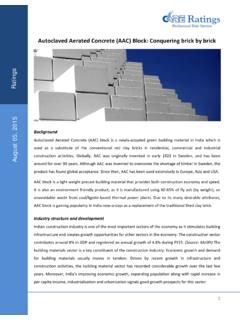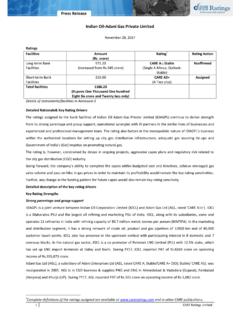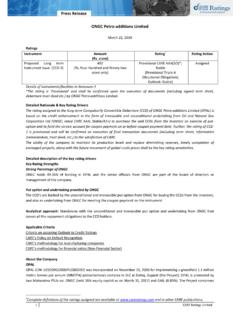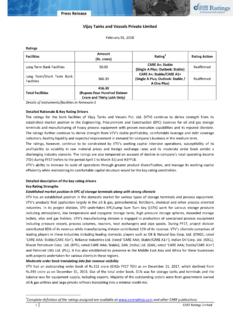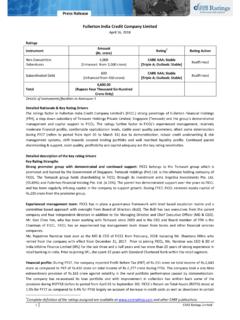Transcription of November 09, 2016 I Economics: Policy View conomic ...
1 In an important move, the Government of India declared yesterday that the five hundred and one thousand rupee notes will no longer be legal tender from midnight, 8th November 2016 . The RBI will issue Two thousand rupee notes and new notes of Five hundred rupees which will be placed in circulation from 10th November 2016 . Notes of one hundred, fifty, twenty, ten, five, two and one rupee will remain legal tender and will remain unaffected by this decision.
2 This measure has been taken by the PM in an attempt to address the resolve against corruption, black money and counterfeit notes. This move is expected to cleanse the formal economic system and discard black money from the same. In this report we highlight the probable consequences of this decision on various economic variables and entities. 1) Effect on parallel economy The removal of these 500 and 1000 notes and replacement of the same with new 500 and 2000 Rupee Notes is expected to - remove black money from the economy as they will be blocked since the owners will not be in a position to deposit the same in the banks, - Temporarily stall the circulation of large volume of counterfeit currency and - curb the funding for anti-social elements like smuggling, terrorism, espionage, etc.
3 2) Effect on Money Supply With the older 500 and 1000 Rupees notes being scrapped, until the new 500 and 2000 Rupees notes get widely circulated in the market, money supply is expected to reduce in the short run. To the extent that black money (which is not counterfeit) does not re-enter the system, reserve money and hence money supply will decrease permanently. However gradually as the new notes get circulated in the market and the mismatch gets corrected, money supply will pick up. 3) Effect on Demand The overall demand is expected to be affected to an extent.
4 The demand in following areas is to be impacted particularly: November 09, 2016 I Economics: Policy view economic consequences of demonetization of 500 and 1000 Rupee Notes Contact: Madan Sabnavis Chief Economist 91-022 -6754 3489 Anushka Sawarkar Associate Economist 91-022-6754 3609 Mradul Mishra (Media Contact) 91-022-6754 3515 Disclaimer: This report is prepared by the Economics Division of Credit Analysis &Research Limited [CARE Ratings]. CARE Ratings has taken utmost care to ensure accuracy and objectivity while developing this report based on information available in public domain.
5 However, neither the accuracy nor completeness of information contained in this report is guaranteed. CARE Ratings is not responsible for any errors or omissions in analysis/inferences/views or for results obtained from the use of information contained in this report and especially states that CARE Ratings has no financial liability whatsoever to the user of this report Economics I economic consequences of demonetization of 500 and 1000 Rupee Notes 2 Consumer goods Real Estate and Property Gold and luxury goods Automobiles (only to a certain limit)
6 All these mentioned sectors are expected to face certain moderation in demand from the consumer side, owing to the significant amount of cash transactions involved in these sectors. 4) Effect on Prices Price level is expected to be lowered due to moderation from demand side. This demand driven fall in prices could be understood as follows: Consumer goods: Prices are expected to fall only marginally due to moderation in demand as use of cards and cheques would compensate for some purchases. Real Estate and Property: Prices in this sector are largely expected to fall, especially for sales of properties where major part of the transaction is cash based, rather than based on banks transfer or cheque transactions.
7 In the medium term, however the prices in this sector could regain some levels as developers rebalance their prices (probably charging more on cheque payment). 5) Effect on various economic entities With cash transaction lowering in the short run, until the new notes are spread widely into circulation, certain sections of the society could face short term disruptions in facilitation of their transactions. These sections are: Agriculture and related sector Small traders SME Services Sector Households Political Parties Professionals like doctor, carpenter, utility service providers, etc.
8 Retail outlets Economics I economic consequences of demonetization of 500 and 1000 Rupee Notes 3 The nature, frequency and amounts of the commercial transactions involved with these sections of the economy necessitate cash transactions on more frequent basis. Thus, these segments are expected to have the most significant impact post this demonetization process and the introduction of new notes in circulation. 6) Effect on GDP The GDP formation could be impacted by this measure, with reduction in the consumption demand. However with the recent rise in festival demand is expected to offset this fall in overall impact.
9 Moreover, this expected impact on GDP may not be significant as some of this demand will only be deferred and re-enter the stream once the cash situation becomes normal. 7) Effect on Banks As directed by the Government, the 500 and 1000 Rupee notes which now cease to be legal tender are to be deposited or exchanged in banks (subject to certain limits). This will automatically lead to more amounts being deposited in Savings and Current Account of commercial banks. This in turn will enhance the liquidity position of the banks, which can be utilized further for lending purposes. However, to the extent that households have held on to these funds for emergency purposes, there would be withdrawals at the second stage.
10 8) Effect on Online Transactions and alternative modes of payment : With cash transactions facing a reduction, alternative forms of payment will see a surge in demand. Digital transaction systems, E wallets and apps, online transactions using E banking, usage of Plastic money (Debit and Credit Cards), etc. will definitely see substantial increase in demand. This should eventually lead to strengthening of such systems and the infrastructure required. CARE s view In spite of the initial hiccups and disruptions in the system, eventually this change will be well assimilated and will prove positive for the economy in the long run.

